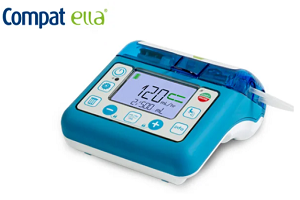COMPAT ELLA® Enteral Feeding pump
COMPAT ELLA® Enteral Feeding pump
An innovative new portable enteral feeding pump, designed from the ground up in collaboration with nurses and users. She is easy-to-learn, easy-to-use, and she also speaks a language you can easily understand: your own. Compat Ella® has a unique colour screen with text displayed in local language. Intuitive programming helps users to get up-and-feeding quickly and the informative screen messaging allows quick problem solving.

Demonstration Videos
USER MANUAL
How do you manually prime a feeding pump?
Overview
To manually prime a feeding pump, you’ll typically need to disconnect the feeding set from the patient, press and hold the “Hold to Prime” button, and then wait for the formula to fill the tubing and reach the feeding tube connector. This process removes air from the tubing and ensures the pump is ready to deliver the feeding solution.
Here’s a more detailed breakdown:
Disconnect the feeding set: Before priming, ensure the feeding set is disconnected from the patient.
Locate the “Hold to Prime” button: Most feeding pumps have a dedicated “Hold to Prime” button, often labeled with a similar icon.
Press and hold the button: Press and hold the “Hold to Prime” button.
Wait for the pump to fill the tubing: The pump will start drawing formula into the tubing and pushing it along. You may need to wait for a few moments, or even a few minutes, for the tubing to fully fill and remove all air bubbles.
Check for flow: Once the priming is complete, the pump should stop drawing formula, and you should see the feeding solution reach the feeding tube connector.
Reconnect the feeding set: Once the tubing is primed and the pump is ready, you can reconnect the feeding set to the patient.
Additional tips:
Consult your pump’s manual:
For specific instructions and troubleshooting tips, always refer to your pump’s manual.
Ensure proper bag placement:
Make sure the feeding bag is properly suspended to allow gravity to assist with the priming process.
Check for air bubbles:
If you see air bubbles in the tubing after priming, you may need to repeat the process or try a different priming method.
Similar Instructions

